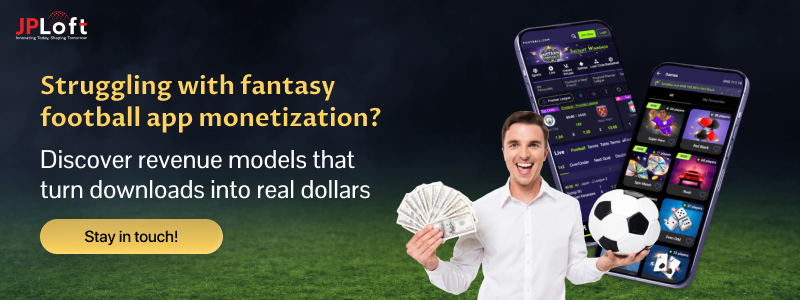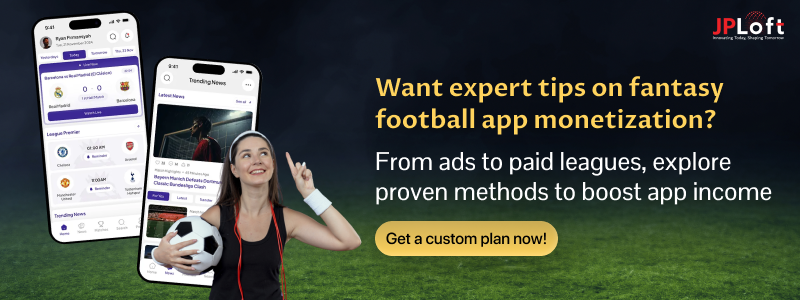Fantasy football app monetization is now a key driver of revenue growth in the booming fantasy sports industry. With millions of users actively participating in fantasy leagues, businesses are exploring how to monetize a fantasy football app beyond basic entry fees.
According to recent reports, the global fantasy sports market is projected to surpass $90 billion by 2027, making it a lucrative space for digital entrepreneurs.
By choosing the right fantasy football revenue model, like ads, subscriptions, or in-app purchases, you can tap into both casual players and die-hard sports fans.
In this blog, we’ll break down proven monetization strategies to help you turn your fantasy football platform into a profit-generating machine.
Key Takeaways
With the global fantasy sports market set to exceed $90 billion by 2027, now is the ideal time to tap into the growing demand for interactive platforms.
Monetization turns your app into a revenue-generating product through smart models like subscriptions, ads, in-app purchases, and contests.
A strong strategy ensures sustainability, attracts investors, funds upgrades, and turns your passion into a scalable business.
Popular models include in-app ads, freemium features, contest entry fees, sponsorships, and affiliate marketing, each offering distinct revenue streams.
Emerging trends like real-time analytics, gamification, and hybrid models are reshaping the industry for all types of users.
As the development team of experts, JPLoft delivers scalable, revenue-ready apps with custom strategies built for success.
What is Fantasy Football App Monetization?
Fantasy football app monetization simply means finding smart ways to earn money from your app. It’s not just about building a fun platform, it’s also about making it profitable.
Whether you’re offering free games with ads or paid leagues with real cash rewards, the goal is to turn your user base into a revenue stream.
When someone asks how to monetize a fantasy football app, the answer usually includes models like in-app purchases, subscription plans, entry fees for premium contests, or showing targeted ads.
Every time a user joins a paid league, buys a virtual good, or subscribes for extra features, you’re generating income. If you plan to develop a fantasy football app, having a clear monetization strategy from the start helps balance great user experience with sustainable revenue growth.
Why Monetization Matters in Your App's Success?
You’ve built a great app, the users are loving it, but what about the returns? That’s where fantasy football app monetization plays a major role. A solid revenue strategy not only supports app maintenance service and growth but also keeps your platform competitive in the long run.
Here’s why monetization is essential for your app’s success:
-
Long-term sustainability:: Knowing how fantasy football apps make money helps you keep the app alive and updated without constantly seeking external funding.
-
Defines your business model:: The right fantasy football app business model guides your pricing, features, and user flow, laying the foundation for consistent growth.
-
Turns passion into profit: With smart strategies, even a free app can generate impressive fantasy football app income through ads, subscriptions, and premium contests.
-
Improves investor appeal: A well-monetized app shows potential investors that your business is not just scalable but also financially viable.
-
Improves User Experience: Monetization allows you to reinvest in your app, whether it's adding new features, improving UI/UX, or offering better rewards. A financially supported app leads to happier, more engaged users who are likely to stay and spend more over time.
So, with the right monetization strategies you can transform your idea into a scalable and rewarding business.
Top Monetization Models for Fantasy Football Apps
Monetization is not an after-launch process, it's the key to your app's long-term success. Whether you're looking to develop a fantasy football app like NFL or something completely different, it's essential to have a good fantasy football app monetization plan.
But the question is: how to monetize a fantasy football app so that it keeps customers satisfied and provides sustainable revenue?
The good news is the fantasy sports market is on fire. Indeed, the global revenue of the fantasy sports market is projected to increase well over $90 billion by 2027.
With a proper model, your app can get a substantial share of the market. Let’s break down the most effective ways to monetize a fantasy football app, with real examples, pros, and best-use scenarios.
1. In-App Advertising
One of the most common ways on how fantasy football apps make money is through in-app advertising. This model works especially well for free apps with a large user base and doesn’t require users to pay directly.
Ads in fantasy football apps are presented in several guises. Banner ads are discreetly shown towards the top or bottom of the screen, and interstitial ads are full-screen and displayed in transitions.
Rewarded video ads allow consumers to view brief videos as an incentive for rewards within the app, such as coins or free entry. Native ads are less obtrusive, integrating with the design of the app so that the experience is smooth.
Why it works:
When implemented thoughtfully, ads don’t disrupt user flow and can generate consistent revenue. Especially in line with current fantasy football app trends, this model works well with large, non-paying audiences and supports app scalability without upfront charges.
2. Entry Fees & Paid Contests
This is one of the most effective revenue streams in fantasy football apps. Users pay an entry fee to join contests or leagues, and winners receive cash prizes. A percentage of the entry pool is retained by the platform as fees, generating direct and scalable revenue.
This model works exceptionally well because it taps into users’ competitive spirit and desire for real-money rewards. It also encourages repeat participation, increasing app engagement over time.
With the support of the best mobile app development company, you can implement secure payment gateways, seamless contest systems, and ensure user trust, maximizing your monetization potential.
Why it works:
It fuels user activity, heightens competition, and unleashes high ROI opportunities, making it a good fantasy football monetization tactic.
3. Freemium Model + In-App Purchases
In the freemium model, users can download the app for free and access basic features, while premium features like advanced analytics, private leagues, or team customization, require payment through in-app purchases.
This strategy lets users explore the app risk-free, increasing their likelihood of upgrading over time. It’s a smart way to build trust and long-term loyalty while gradually increasing fantasy football app revenue.
Businesses that hire dedicated developers can fine-tune the in -app experience, personalize upgrade prompts, and integrate smooth purchase mechanisms, ensuring higher conversion and retention rates.
Why it works:
It can appeal to a broader audience and then increasingly turn loyal users into paying subscribers. It's also very good for selling virtual goods that don't need supplemental infrastructure.
4. Subscription-Based Monetization
The subscription model for fantasy football is a fan favorite, especially among loyal users seeking premium experiences. Instead of paying once, users subscribe on a monthly, seasonal, or yearly basis, aligned with their preferences and the sports calendar.
In return, they unlock a suite of exclusive benefits such as ad-free gameplay, real-time match updates, expert tips, and access to invite-only leagues. These offerings often represent the key features of fantasy football app platforms that aim to keep serious players engaged and satisfied.
This monetization strategy ensures steady revenue while enhancing user satisfaction, making it one of the most reliable and scalable approaches in the fantasy football app business model.
Why it works:
It generates stable monthly fantasy football app revenues and creates user loyalty. If you're curious about how to profit from a fantasy football app in a sustainable way, a tiered subscription model is a great path, particularly combined with free trials or one-time purchases.
5. Sponsorships & Brand Collaborations
Collaborating with sporting brands, influencers, or veteran fantasy communities may provide access to influential sponsorship opportunities.
These partnerships usually come in the form of sponsoring in-app competitions, subsidizing reward pools, or providing branded items such as unique team kits or digital badges.
Aside from helping to monetize a fantasy football app, these sponsorships also add credibility and appeal to it, particularly when tied with popular individuals or reputable brands within the sports community.
Why it works
This not only enhances app trustworthiness but also provides an additional stream of revenue that doesn't depend on users paying out directly. It also fits well with the user-centric strategy of most fantasy football app business models.
6. Affiliate Marketing
You may also earn revenue by promoting affiliate products, services, or companion apps within your fantasy football application.
For example, displaying links to sporting equipment, fantasy-related paid memberships, or companion apps such as news or prediction apps enables you to receive a commission on each user purchasing or signing up through your app.
This tactic not only increases your fantasy football app revenue but also improves the user experience by providing useful suggestions.
Why it works:
Affiliate links may be displayed in blogs, game previews, or even push messages, making it a passive yet successful source of fantasy football app revenue.
Knowing how fantasy football apps generate revenue is critical for sustained success. A robust fantasy football revenue model not only stimulates user engagement but also creates real business value.
Whether subscriptions, advertising, or paid leagues, the aim is to achieve that ideal balance between user satisfaction and profitability.
So, if you’re ready to launch or scale, make sure your fantasy football app monetization strategy is built for both current market needs and future growth.
Best Fantasy Football Apps and How They Monetize
If you're planning to build a fantasy football app, it’s smart to take inspiration from the best in the game. From intuitive designs to innovative revenue strategies, these apps lead the way in shaping user expectations.
But while they shine in performance, they also highlight some common challenges of fantasy football app development, such as maintaining real-time data sync, handling user scalability, and creating monetization without hurting user experience.
Let’s explore five of the top fantasy football apps and break down how they successfully monetize their platforms while keeping users engaged.
A] Fantasy Football Draft Wizard
This app is a go-to for draft preparation. It offers mock drafts, expert rankings, and personalized advice. The app follows a freemium model users get basic simulations for free.
But advanced features like draft syncing, premium cheat sheets, and player comparison tools are behind a paywall. Subscriptions are offered on monthly and seasonal bases, helping the app build recurring revenue.
This approach shows how premium features can be used to offer real value while boosting monetization.
B] DraftKings
DraftKings is a leader in daily fantasy sports, offering real-time stats, dynamic leaderboards, and high-stakes contests across multiple sports. It monetizes through paid contest entries, brand partnerships, and ads, making it one of the most profitable platforms in the space.
If you're planning to develop an app like DraftKings, focus on secure payment systems, legal compliance, and scalable infrastructure. Its success proves that with the right features and strategy, fantasy sports apps can thrive in both user engagement and revenue.
C] Biwenger
Popular in Europe and Latin America, Biwenger combines fantasy football with a sleek social experience. Users can compete in leagues, manage teams, and analyze detailed stats.
Biwenger monetizes through ad removal, in-app purchases, and premium league customizations. It even offers optional payments for enhanced player stats and analytics.
The app's regional appeal also reminds us that developers must hire mobile app developers who understand local user behavior and regulations to build globally competitive fantasy apps.
D] NFL Fantasy Football
As the official fantasy platform of the NFL, this app delivers top-tier user experience, live scoring, and player updates all for free. But it monetizes through sponsorships, brand partnerships, and content ads, thanks to its wide audience reach.
Its integration with official league content also sets it apart. This shows that even without a paid tier, high-quality content and strategic branding can make fantasy football apps profitable.
E] Draft Punk
Draft Punk is known for helping users create winning teams through its real-time draft assistant and customizable interfaces.
The app follows a freemium + one-time purchase model, giving users a taste of its features for free, while charging for deeper tools like draft board syncing and trend tracking.
Its monetization strategy is focused yet flexible, and it capitalizes on the desire for competitive advantage, a smart way to build a loyal user base.
F] Dream Team Fantasy Football
Developed by The Sun, Dream Team mixes sports journalism with fantasy gameplay. It monetizes through paid league entries, advertising, and branded sponsorships, while keeping its core app free.
The integration of football news, videos, and expert insights adds content value, increasing retention and monetization opportunities.
This app highlights how blending content and gameplay can drive fantasy football app revenue across multiple channels.
From paid subscriptions and freemium tiers to sponsorships and branded content, each app showcases different ways to turn downloads into dollars. By learning from these top players and partnering with the right development company, you can build a monetization strategy that works long-term.
How JPLoft Can Help You Monetize Your Fantasy Football App?
As a leading fantasy football app development company, JPLoft brings in-depth expertise and a user-first approach to help you build, scale, and monetize your app with maximum efficiency.
Whether you want to implement freemium features, paid leagues, or in-app purchases, our team of experienced developers ensures that your app is technically sound, visually engaging, and revenue-ready from day one.
We specialize in developing apps that support multiple monetization models, from subscriptions and affiliate integrations to real-money contests and virtual goods. Our solutions are designed to increase user retention, boost lifetime value, and deliver an immersive experience across Android, iOS, and web platforms.
From MVP to full-scale deployment and post-launch support, we help transform your monetization strategy into a real, profitable outcome, making us your trusted partner in fantasy football app success.
Final Wrap-Up
Monetization plays a crucial role in building a sustainable and scalable business around fantasy sports. From paid contests and in-app purchases to affiliate marketing and subscription models, there are plenty of ways to turn your platform into a revenue-generating powerhouse.
However, every model must be backed by a strong app experience, user-friendly design, and reliable features. If you're serious about building a next-gen fantasy football app, make sure you incorporate strategies that align with your audience's behavior and expectations.
And don’t forget that the fantasy football app monetization journey becomes a lot easier when you partner with the right development team.
FAQs
It depends on your audience. Entry fees, subscriptions, and in-app purchases are among the most effective for consistent revenue.
Yes, you can use freemium models, display ads, affiliate marketing, or sell digital goods to generate income even with a free app.
Offer strong value, like expert analytics, exclusive leagues, and real-time updates to make the premium upgrade worthwhile.
Absolutely. With increasing user engagement and sports popularity, these apps offer great monetization potential when built well.
Major challenges include user retention, payment gateway integration, legal compliance, and keeping features competitive.













Share this blog